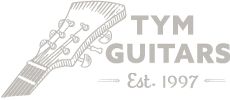Late 60's Teisco KB2
Share
If you're a regular here you've read a lot about Teisco and you know how much I love them, especially the K series guitars and basses. And pretty much everything else they made ... search for Teisco on this site and you'll get a few hits if you're interested.
The K series guitars were introduced in '66 to much fanfare. The boom had been increasing since '64 in Japan and guitars were being manufactured, and selling at an amazing rate.

I'll do a separate blog on the K series Teiscos when I get time as I have owned and sold many and we pretty much always have them for sale in the shop. For now, let's look at this great bass.
The bass version of the K series started the following year in early '67 and are much rarer than the quite common guitar versions which were available in 2, 3 and 4 pickup versions. It's rare to see a striped scratchplate version of the bass that isn't one of the later re-issues as that plate type had been mostly phased out by the time the bass version came along and all have the GREAT hooked 3/1 (4/2 on the guitar) headstocks.


These are a solid body in exactly the same size and thickness as the guitar version, which was common in mid sixties Japanese guitars like most Teiscos, Guyatones etc. The short 30" scale worked well with smaller bodies and meant machines could be used to make one body for mass production and depending on which version is was depended on where and how the pickup/control cavities and (in some cases) vibrato routs were placed.


These K series (sometimes known as "shark fin" guitars) are one of the most unique and instantly recognizable shapes in guitar history. It's a beautiful very slightly offset shape with great pointed non symmetrical horns. I personally think it's one of the great guitar designs as aesthetically pleasing as many "big brand" shapes.


The German carve is very nicely done and is not the simple "router around the edge" style as used on many cheaper Japanese guitars from the sixties. This flows more organically than the simple carves as it it moved in and out of the corners, points and curves. Even the headstock has a subtle carve.

The neck is thin and, like the guitar version, doesn't get much thicker as you go up the neck. As the neck pocket is the same as the guitar pocket it's still quite narrow at the body end and the string spacing is close, but very comfortable all the way up. As with most Teiscos from this period, it has a zero fret and plastic string guide.


The body has a sides on the neck pocket like other Teiscos at the time which looks a little ... imposing but is actually not an issue even when playing around the body end of the neck.

The pickups are strong and clear. I love a lot of this period Teisco (and other Japanese manufacturers) pickups as most brands/companies were making very well designed and built electronics. For years these pickups were looked at as being "cheap and nasty" as the guitars they were attached to were looked on similarly, but I've always been a huge fan and never understood the bad reputation.


This bass has LOTS of checking, yellowing and player wear but looks AWESOME. You don't often see these guitars with this level of checking as the finishes used by many of these companies was modern forms of poly (ester not urethane) and doesn't "crack up" like most pre mid 60's US guitars. This one however may have been played in hot/cold/wet/dry clubs ever night to make it look like a heavily checked nitro finish.

The timber and build quality is good throughout and it plays and sounds great and is still all original, which as I've said many times, is exceptional for a 50 year old "cheap" guitar.


The original round headstock badge and bridge cover are missing but everything else is intact. The bridge covers are nearly always missing as you need to remove them to restring the bass and many people just left them off after putting new strings on.

